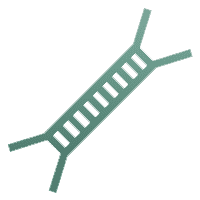eCLIP-seq: A Rapid, Low-Input, High-Throughput Technology for Protein-RNA Interaction Analysis
Overview
Service
Application
FAQ
Inquiry
eCLIP-seq is advancing the study of RNA-protein interactions. This advanced technique delivers high accuracy and efficiency, providing researchers with reliable tools to gain new insights. Whether you're investigating neural development, cancer biology, or gene regulation, eCLIP-seq makes complex studies more accessible.
By addressing the challenges of older methods, eCLIP-seq streamlines processes and reduces the amount of material needed. Its precision and quality outputs enable researchers to confidently pursue their experiments with greater ease.
At CD Genomics, we provide eCLIP-seq services that are built to meet specific research demands. From handling samples to delivering detailed analysis, our comprehensive support ensures your efforts remain focused on generating meaningful results.
Start your next research step with CD Genomics and experience the benefits of eCLIP-seq firsthand. Connect with us to explore how our services can support your scientific goals effectively.
What is eCLIP?
eCLIP (enhanced cross-linking immunoprecipitation) is a refined method for studying RNA-protein interactions. By using innovative barcoded adapters, eCLIP eliminates amplification bias, providing high-resolution insights into how proteins interact with RNA. Researchers often rely on eCLIP to explore post-transcriptional regulation and its implications in gene expression.
eCLIP vs. CLIP: What's the Difference?
The widespread application of current CLIP technologies faces two critical obstacles. The first is a procedural bottleneck: CLIP-based methods require SDS-PAGE to separate proteins, followed by manual excision of specific bands. This labor-intensive step introduces operator variability and takes extra time. The second limitation is specificity, as each RNA-binding protein (RBP) necessitates a tailored immunoprecipitation (IP) step, requiring significant input material.
To address these constraints, eCLIP integrates DNA barcode-labeled antibodies, eliminating SDS-PAGE and membrane transfer steps with on-bead proximity-based ligation. This innovation reduces input requirements while enabling simultaneous identification of multiple RBPs, transforming workflows and expanding the analytical capacity of CLIP technologies.
| Feature |
eCLIP |
Traditional CLIP |
| Sensitivity |
High (reduced amplification bias) |
Moderate |
| Workflow Complexity |
Streamlined |
Complex |
| Applications |
Advanced RNA-protein studies |
General RNA studies |
eCLIP vs. iCLIP: A Comparative Analysis
eCLIP optimizes data quality by requiring fewer PCR cycles, resulting in better library diversity and a higher percentage of usable reads. For example, eCLIP needs about 13 PCR cycles to produce 100 fmol of DNA, while iCLIP requires roughly 23.6 cycles.
| Feature |
eCLIP |
iCLIP |
| Ligation Method |
Two-step adapter ligation |
Circular ligation |
| Bias in Data |
Minimal |
Moderate |
| Workflow Complexity |
Lower |
Higher |

Why Choose CD Genomics for Your eCLIP-seq Service?
| Feature |
Details |
| Advanced Technology |
Access state-of-the-art sequencing platforms. |
| Comprehensive Support |
From sample preparation to detailed data analysis. |
| Expert Team |
Work with skilled scientists who specialize in RNA research. |
Explore our CLIP-sequencing services to tailored to meet the unique needs of your experiments or projects.
Workflow of eCLIP-seq Service

1. Sample Preparation
UV Crosslinking: Stabilizes RNA-protein complexes.
Cell Lysis: Releases crosslinked complexes.
RNase Digestion: Fragments RNA, leaving protected regions.

2. Library Preparation
Immunoprecipitation
Adapter Ligation
Reverse Transcription
cDNA Amplification

3. Sequencing
Generates paired-end reads for analysis.

4. Data Analysis
Includes deduplication, genome mapping, peak calling, and motif discovery.
Bioinformatics Analysis Pipeline
 Illustration of the eCLIP bioinformatics workflow process. (Steven Blue et al,. 2022)
Illustration of the eCLIP bioinformatics workflow process. (Steven Blue et al,. 2022)
Sequencing Quality Distribution
Quality control of raw reads using tools like FastQC
Adapter trimming and removal of low-quality bases
Assessment of sequence duplication levels
Peak Calling and Visualization
Identification of binding sites using specialized algorithms like PEAKachu
Adjustment of parameters such as minimum block overlap and minimum cluster expression fraction
Generation of bigwig/wig files for visualization in genome browsers
Peaks Width and Distance Analysis
Statistical refinement of peak widths based on CLIP cluster distributions
Examination of the fraction of overlaps in each nucleotide relative to peak positions
Analysis of peak distances to identify potential binding patterns
Identification of Potential miRNA Targets
Use of chimeric eCLIP to capture miRNA:mRNA interactions
Integration of AGO2 eCLIP with chimeric ligation step for improved recovery of miRNA:mRNA interactions
Distribution Analysis of Peaks
Mapping of peaks to genomic features (e.g., exons, introns, UTRs)
Analysis of peak distribution across different transcript regions
Comparison of peak distributions between replicates and controls
Analysis of microRNA-mRNA Interactions
Identification of miRNA binding sites using chimeric eCLIP data
Enrichment of libraries for specific miRNAs of interest using PCR or probe capture
Validation of miRNA-mediated repression through RNA-seq analysis
Identification of Protein Binding Sites
Extraction of site context for each peak region using tools like Peakhood
Analysis of exon and intron coverage to determine transcript or genomic context
Selection of most likely site-transcript combinations based on read, site, and transcript statistics
Differential Binding Analysis
Use of tools like DEWSeq for detecting significantly enriched binding sites
Implementation of sliding window approaches for different binding modes of RBPsComparison of binding sites between different conditions or cell types
Motif Search of Enrichment Sites
Analysis of peaks to find potential binding motifs
Comparison with known motifs from databases
Use of tools like HOMER for de novo motif discovery
GO and KEGG Pathway Analysis
Functional annotation of genes associated with identified binding sites
Enrichment analysis of Gene Ontology (GO) terms
Analysis of KEGG pathways to identify biological processes affected by RBP binding
Applications of eCLIP-seq
Neurobiology:
eCLIP has significantly advanced our understanding of RNA regulation in neural development. A key study by Vuong et al. showcased its utility in mapping RBFOX1 binding sites in human neural progenitor cells and differentiated neurons. The results were striking. RBFOX1 was found to regulate alternative splicing events that are essential for neuronal maturation and synaptic function, shedding light on the intricate molecular processes underpinning neural development.
Cancer Research:
In the realm of cancer research, eCLIP has provided profound insights into how RNA-binding proteins influence tumor progression. A pivotal study by Van Nostrand et al. employed eCLIP to profile 150 RNA-binding proteins across K562 and HepG2 cell lines. This large-scale analysis unveiled new RNA regulatory patterns in cancer cells. What's remarkable is how these findings hinted at unexpected RNA processing principles that could have broad implications for various cancers, offering new avenues for therapeutic exploration.
Developmental Biology:
eCLIP's contributions to developmental biology are equally noteworthy. Jankowsky and Harris, for instance, utilized the method to probe the role of the DEAD-box RNA helicase Ddx5 in zebrafish development. Their discovery was eye-opening. Ddx5 was found to regulate genes critical for early embryonic patterning and organogenesis. These insights highlight the pivotal role of RNA-binding proteins in orchestrating the complexities of development.
Glioblastoma Research:
Although direct studies on glioblastoma were not highlighted, eCLIP has undoubtedly played a role in cancer research more broadly. For example, the ENCODE project's eCLIP data has proven invaluable in examining RNA-binding proteins in glioblastoma. A study by Xue et al. harnessed this data to uncover potential therapeutic targets, underscoring eCLIP's power in identifying molecular players that could guide future treatment strategies.
Frequently Asked Questions about eCLIP-seq
-
-
How does eCLIP improve RNA-protein interaction mapping over traditional CLIP methods?
-
-
Why is eCLIP particularly suited for studying rare RNA-protein interactions?
-
-
What kind of data does eCLIP typically generate?
-
-
How does the ligation process in eCLIP improve over iCLIP?
-
Unlike iCLIP, which often uses circular ligation, eCLIP employs two separate adapters for ligation. This segmented approach minimizes amplification bias, enhances reproducibility, and leads to superior data quality.
-
-
Why eCLIP Outperforms Other Methods
-
| Feature |
eCLIP |
Traditional Methods (CLIP/iCLIP) |
| Sensitivity |
Higher |
Moderate |
| Workflow Complexity |
Lower |
Higher |
| Typical Read Length |
Up to 150 bp |
Varies |
| Binding Site Detection |
Enhanced with barcoded adapters |
Standard detection |
References:
- Ule, J., Jensen, K., Mele, A., & Darnell, R. B. (2005). CLIP: a method for identifying protein-RNA interaction sites in living cells. Methods, 37(4), 376-386. https://doi.org/10.1016/j.ymeth.2005.07.018
- Wheeler, E. C., Van Nostrand, E. L., & Yeo, G. W. (2018). Advances and challenges in the detection of transcriptome-wide protein-RNA interactions. Wiley Interdisciplinary Reviews: RNA, 9(1), e1436. https://doi.org/10.1002/wrna.1436
- Hafner, M., Katsantoni, M., Köster, T., Marks, J., Mukherjee, J., Staiger, D., Ule, J., & Zavolan, M. (2021). CLIP and complementary methods. Nature Reviews Methods Primers, 1, 20. https://doi.org/10.1038/s43586-021-00018-1
- Daniel, L., Sundararaman, B., Blue, S. M., Nguyen, T. B., Zheng, S., Dominguez, D., Graveley, B. R., & Yeo, G. W. (2023). Multiplexed transcriptome discovery of RNA-binding protein binding sites by antibody-barcode eCLIP. Nature Methods, 20(1), 65-69. https://doi.org/10.1038/s41592-022-01679-w
- Van Nostrand, E. L., Pratt, G. A., Shishkin, A. A., Gelboin-Burkhart, C., Fang, M. Y., Sundararaman, B., Blue, S. M., Nguyen, T. B., Surka, C., Elkins, K., Stanton, R., Rigo, F., Guttman, M., & Yeo, G. W. (2016). Robust transcriptome-wide discovery of RNA-binding protein binding sites with enhanced CLIP (eCLIP). Nature Methods, 13(6), 508-514. https://doi.org/10.1038/nmeth.3810
* For Research Use Only. Not for use in diagnostic procedures.





 Illustration of the eCLIP bioinformatics workflow process. (Steven Blue et al,. 2022)
Illustration of the eCLIP bioinformatics workflow process. (Steven Blue et al,. 2022)